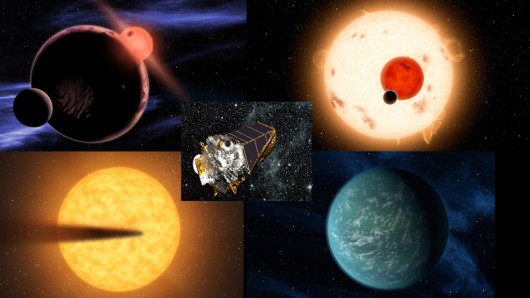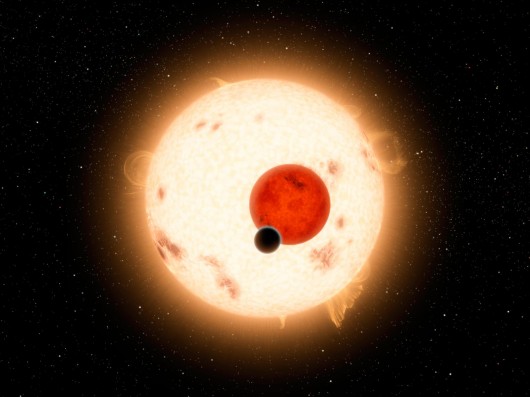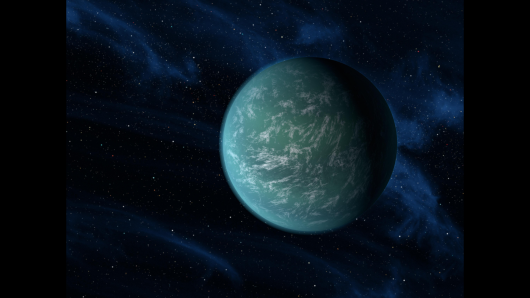Kepler’s five-year tally: 961 new planets
By Bob Guntrip
March 19, 2014

“Kepler has produced results needed to take the next big step forward in humankind's search for life in our galaxy” – William Borucki, Kepler principal investigator at NASA's Ames Research Center (Image credits: NASA, Ames/R. Hurt/JPL-Caltech, D. Aguilar/Harvard-Smithsonian Center for Astrophysics, Lynette Cook/extrasolar.spaceart.org)
It’s five years this month since NASA’s $600 million Kepler Space Telescope was launched to look for planets beyond our Solar System – so-called exoplanets – and while the quest to find a twin for Earth has so far been fruitless, Kepler’s observations have revealed our galaxy to be full of worlds potentially able to support life.
Kepler’s observations ended in August 2013 when a mechanical failure made it impossible to aim the telescope accurately. But by then scientists had sifted through data received from Kepler’s continuous observation of more than 150,000 star systems to find 3600 possible planets, and then reduce that figure to 961 firm identifications.
More than half of all known exoplanets were discovered through Kepler, and we now know that most stars have planets in orbit around them, with as many as one in five of these able to support life – which could add up to a staggering 40 billion habitable worlds in our galaxy alone, according to NASA.
Kepler came online on May 12, 2009 and had soon found its first planets, five “hot Jupiters”, so called because of their enormous size and orbits close to their stars. Since then the orbiting observatory has revealed some of the wonders of our galaxy. In September 2011, Kepler data confirmed the existence of a world with a double sunset like the one famously portrayed in the film Star Wars. The discovery of Kepler-16b turned science fiction into science fact. Since then, the discoveries of six additional worlds orbiting double stars further showed planets can form and survive in double-star systems, giving a new class of planetary system.
Artist's conception of Kepler-16b, the most "Tatooine-like" planet yet found in our galaxy (Image: NASA/JPL-Caltech/R. Hurt)
In December 2011, NASA announced Kepler's most exciting discovery yet: Kepler-22b, a world about 2.4 times the size of Earth, orbiting a Sunlike star in the “habitable zone” – the orbital region around a star in which an Earthlike planet can possess liquid water on its surface, a critical requirement for life as we understand it.
Artists depiction of Kepler-22b, a world about 2.4 times the size of Earth, orbiting a Sunlike star in the “habitable zone” (Image: NASA/Ames/JPL-Caltech)
Kepler found its first Earth-size planet with Earth-size mass in 2013, when scientists identified Kepler-78b, a rock/iron-based world orbiting very close to its star in the constellation of Cygnus, some 400 light-years from Earth.
“Kepler has produced results needed to take the next big step forward in humankind's search for life in our galaxy,” explained William Borucki, Kepler principal investigator at NASA's Ames Research Center in Moffett Field, California. “To provide information needed for future missions that will ultimately determine the atmospheric composition of Earth-sized exoplanets to discover if they could be habitable."
No longer able to fulfill its primary function, the future of the Kepler Space Telescope is under review by NASA, while a proposal for it to continue hunting planets by employing a different technique – presently dubbed K2 – will be considered for funding by NASA at the 2014 Astrophysics Senior Review of Operating Missions.
Head through to the gallery to see more artist's impressions of the extraordinary worlds discovered by the Kepler Mission since 2009.
copyright © Gizmag 2003 - 2014
http://www.gizmag.com/kepler-five-year-anniversary-961-new-planets/31197

